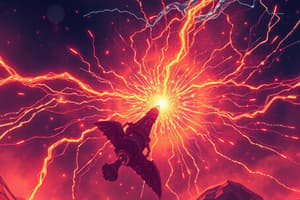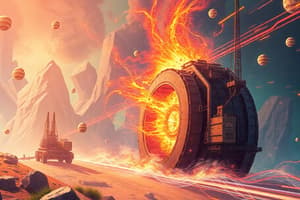Podcast
Questions and Answers
What defines work done by a force on an object?
What defines work done by a force on an object?
- A force must be exerted without any movement.
- The object must rotate as a result of the force.
- The object must move due to the force exerted. (correct)
- The force must exceed the weight of the object.
What is the SI unit of work?
What is the SI unit of work?
- Newton
- Meter
- Joule (correct)
- Pound
Which of the following describes positive work?
Which of the following describes positive work?
- When force and displacement are in opposite directions.
- When force has no component in the direction of displacement.
- When the force is applied perpendicular to the displacement.
- When force has a component in the direction of displacement. (correct)
What is the relationship between work and kinetic energy?
What is the relationship between work and kinetic energy?
What happens to the work done if the force is exerted at an angle to the displacement?
What happens to the work done if the force is exerted at an angle to the displacement?
Which of these statements is true regarding the work done against gravity?
Which of these statements is true regarding the work done against gravity?
Which of the following equations represents work done by a constant force?
Which of the following equations represents work done by a constant force?
What characterizes negative work?
What characterizes negative work?
What is true when the force is perpendicular to the displacement of an object?
What is true when the force is perpendicular to the displacement of an object?
What happens to the kinetic energy of a particle when it is at rest?
What happens to the kinetic energy of a particle when it is at rest?
How does kinetic energy change with the speed of an object?
How does kinetic energy change with the speed of an object?
According to the work-energy theorem, what does the work done by the net force on a particle equal?
According to the work-energy theorem, what does the work done by the net force on a particle equal?
What is true about the work done by external forces acting on the skater?
What is true about the work done by external forces acting on the skater?
What effect does total work have on a particle's speed?
What effect does total work have on a particle's speed?
What is the relationship between mass and kinetic energy?
What is the relationship between mass and kinetic energy?
When does a weightlifter do no work on a barbell?
When does a weightlifter do no work on a barbell?
What does the work done by a varying force from position $x_1$ to $x_2$ depend on?
What does the work done by a varying force from position $x_1$ to $x_2$ depend on?
How is the work done on a spring to stretch it a distance $X$ expressed mathematically?
How is the work done on a spring to stretch it a distance $X$ expressed mathematically?
What is the SI unit of power?
What is the SI unit of power?
Which of the following formulas represents average power?
Which of the following formulas represents average power?
What is the relationship between force and the distance a spring is stretched?
What is the relationship between force and the distance a spring is stretched?
In the context of motion along a curve, how is work found?
In the context of motion along a curve, how is work found?
What is instantaneous power?
What is instantaneous power?
If a force varies with position, what is the first step to calculate the total work done?
If a force varies with position, what is the first step to calculate the total work done?
Flashcards are hidden until you start studying
Study Notes
Work
- Work done by a force involves a displacement of the object the force is acting on.
- Unit of work is the Joule (J) which is defined as 1 Newton (N) of force multiplied by 1 meter (m) of distance.
- Positive work occurs when the force component is in the direction of displacement.
- Negative work occurs when the force component acts opposite to the direction of displacement.
- Zero work occurs when the force is perpendicular to the displacement.
Kinetic Energy
- The energy of motion of an object is referred to as kinetic energy.
- The amount of kinetic energy is dependent on mass and speed, not direction.
- Kinetic energy can never be negative and is only zero when the object is at rest.
- The SI unit of kinetic energy is the Joule.
Work-Energy Theorem
- The work done by the net force on a particle is equal to the change in the particle's kinetic energy.
Power
- Power is the rate at which work is done.
- Average power is calculated by dividing the work done by the time taken.
- Instantaneous power is calculated by taking the derivative of work with respect to time.
- The SI unit of power is the Watt (W), which is equivalent to 1 Joule (J) per second (s).
- Another unit of power is the horsepower (hp) which is equivalent to 746 Watts (W).
Work Done by a Varying Force
- When the force is not constant, the work done can be calculated by integrating the force over the displacement.
- The total work done by the force over a distance is represented by the area under the curve of force versus position.
Work - Energy Theorem for Curved Path
- The work done by a force along a curved path is represented by a line integral of the force along the path.
Stretching a Spring
- The force required to stretch a spring is proportional to the distance it is stretched.
- The work done to stretch a spring is equal to 1/2 times the spring constant (k) multiplied by the square of the distance stretched.
Examples
- When a force is applied to an object at an angle to the direction of motion, only the component of the force parallel to the motion will do work.
- The work-energy theorem can be used to calculate the speed of an object after a certain amount of work has been done on it.
- The power output of a motor can be calculated by dividing the work done by the time taken.
Studying That Suits You
Use AI to generate personalized quizzes and flashcards to suit your learning preferences.




